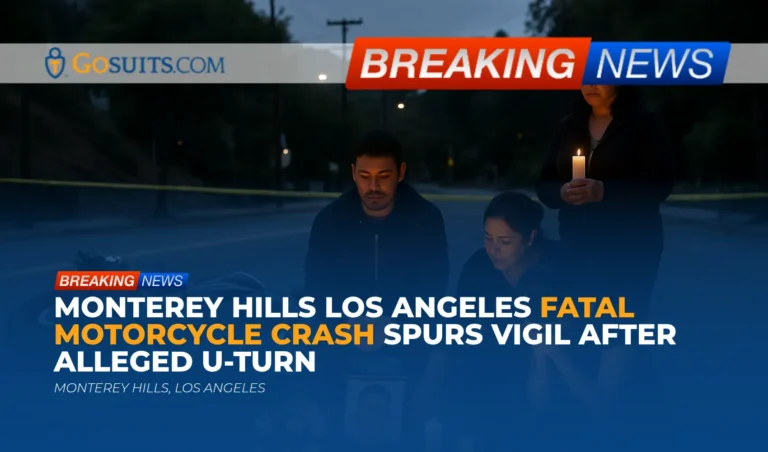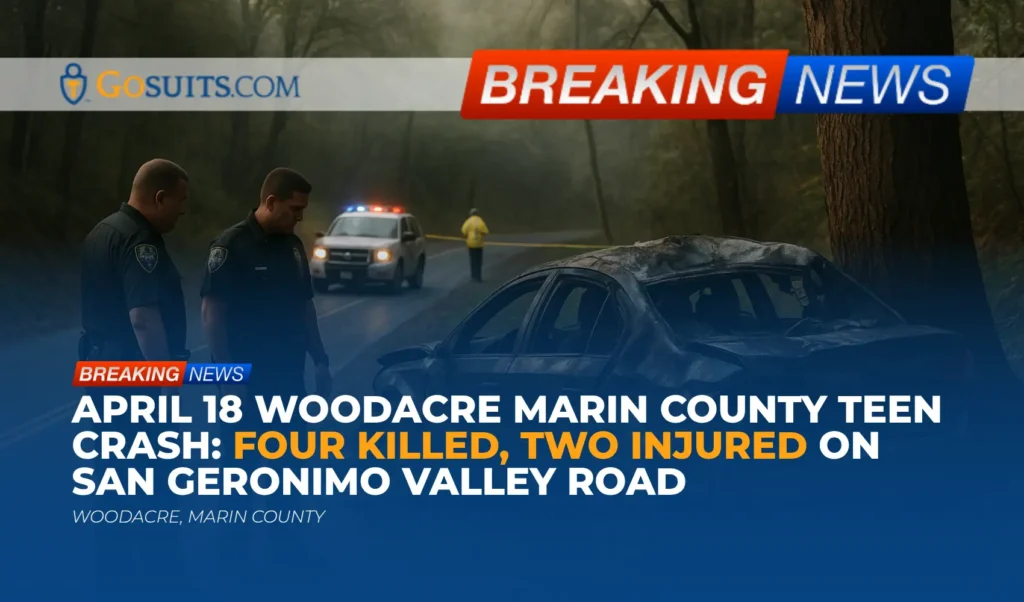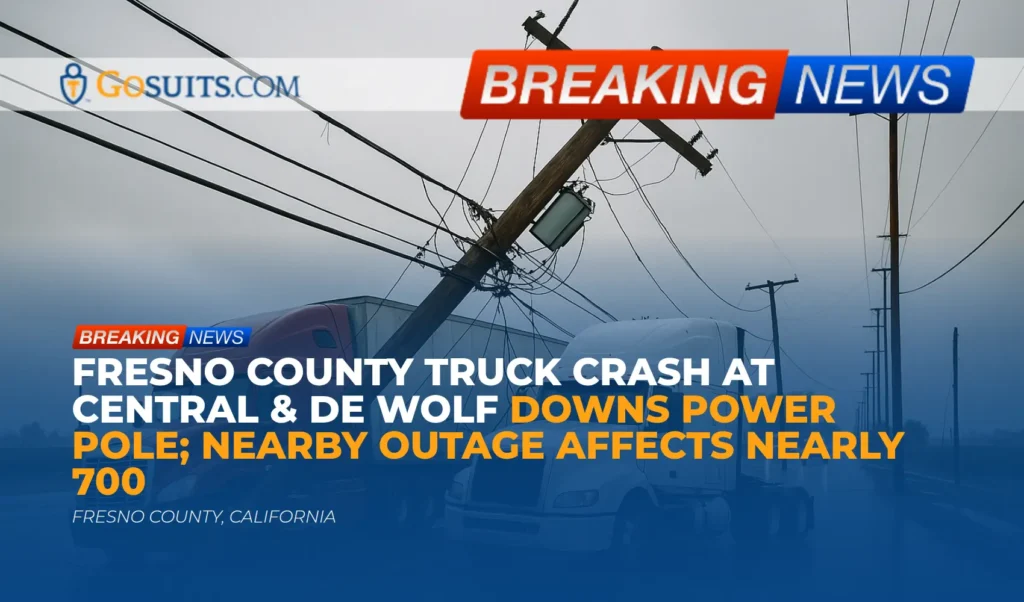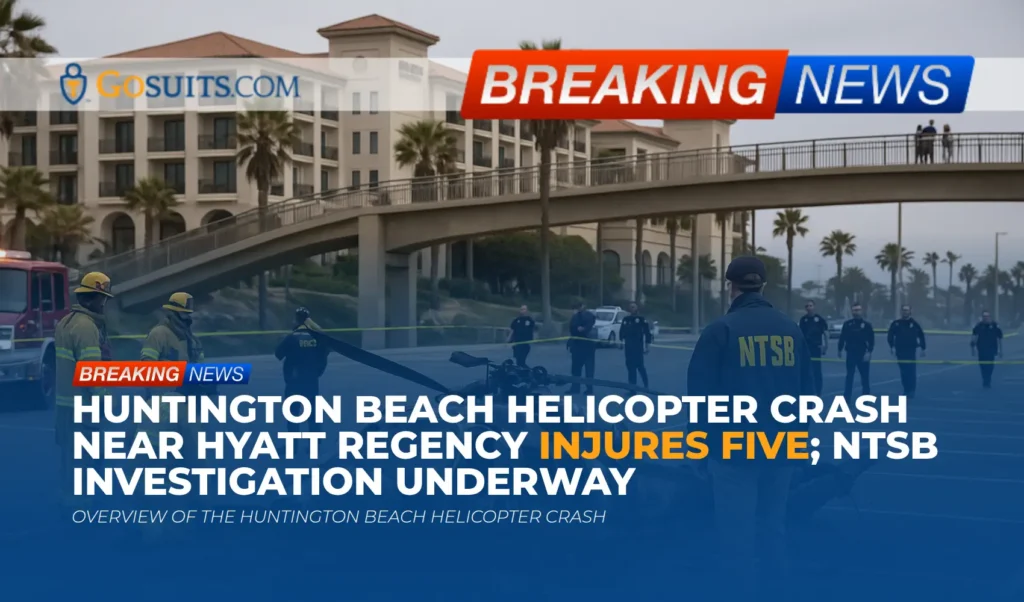- What we know about the Monterey Hills motorcycle crash
- Where and when the crash occurred
- Immediate safety takeaways for drivers and motorcyclists
- Possible civil liability and key California traffic laws
- Understanding wrongful death and survival actions in California
- Insurance considerations after a fatal motorcycle crash
- What families can consider in the first days and weeks
- Where to obtain official records and support in Los Angeles County
- How crash investigations typically proceed
- Data and laws relevant to U-turn and left-turn collisions
- Types of losses often claimed in wrongful death cases
- Caution when speaking with insurance companies
- Commentary from Gosuits Los Angeles, California Personal Injury Attorney
- Why taking timely action matters
What we know about the Monterey Hills motorcycle crash
A family in Los Angeles gathered for a vigil honoring a 28-year-old motorcyclist who lost his life after a collision in the Monterey Hills area. According to loved ones, a driver allegedly attempted a U-turn in front of the motorcycle, leading to a fatal impact. Family members described the area as one where drivers often travel at high speeds, and they expressed a desire to raise awareness to protect others on the road. They also indicated an intention to establish a foundation in the rider’s name.
As of the time of reporting, the statements about how the collision occurred come from the family’s account. Official investigations by law enforcement typically determine the full set of facts, including speed, right-of-way, sight lines, traffic controls, and any potential contributing factors. It is normal for collision investigations to take weeks or longer before final determinations and reports are available.
Where and when the crash occurred
The incident took place near the corner of Monterey Road and Kendall Avenue in the Monterey Hills area of Los Angeles. The report was shared publicly on a Monday news segment, and the family’s vigil occurred Sunday night. Monterey Hills lies within the City of Los Angeles and includes roadways with changing grades, curves, and intersections that can create complex sight lines. Intersections with U-turn movements require particular attention from drivers because vehicles traveling straight generally have the right-of-way unless and until a turning driver can safely complete the maneuver.
For the community, identifying the precise location matters. Intersections with frequent conflicts between turning drivers and through traffic are sometimes candidates for engineering review. Residents can typically raise concerns about signage, lighting, signal timing, and speeding through their local transportation department, while recognizing that law enforcement remains responsible for crash investigation and enforcement.
Immediate safety takeaways for drivers and motorcyclists
In moments like this, the focus is on supporting the family and the community. It is also an opportunity to remember the roadway behaviors that reduce risk.
- Drivers making U-turns or left turns must yield to oncoming traffic until it is safe to proceed. This is a core right-of-way rule in California.
- Scan for motorcyclists. Riders present a smaller visual profile and can be harder to detect. Actively look for them before turning or entering an intersection.
- Control speed. Speed affects stopping distance and field of view. Slower, deliberate turns reduce the chance of misjudging a rider’s approach.
- Nighttime and visibility. Headlights, reflective gear for riders, and clean windshields for drivers improve detection.
- Avoid distractions. Even a brief glance away from the roadway can lead to catastrophic outcomes at intersections.
California’s driver handbook emphasizes that U-turns should be made only when safe and legal and that drivers must yield to oncoming traffic before turning. See the California DMV Driver Handbook for general safety guidance.
Possible civil liability and key California traffic laws
While every collision is unique, an allegation that a driver executed a U-turn into the path of an oncoming motorcycle raises important right-of-way considerations. In California, drivers intending to turn left or complete a U-turn must yield to vehicles approaching from the opposite direction until the turn can be made with reasonable safety. This duty is reflected in California Vehicle Code §21801.
Additional turning and U-turn controls appear in other vehicle code provisions and the DMV handbook, including the requirement to ensure the movement can be completed safely and is permitted at that location. Not all intersections allow U-turns, and even where allowed, drivers must proceed with caution. The key civil-liability question is whether a reasonably careful driver in the same situation would have yielded and waited for a safe gap. If a turning driver violates the right-of-way, a civil claim for negligence may be available to the injured party or, in a fatality, to eligible family members through a wrongful death claim.
California follows rules that allocate responsibility based on each party’s share of fault when necessary. For example, if evidence showed both turning and through-traffic behaviors contributed, fault can be apportioned. Determining fault requires a careful review of the collision report, witness statements, physical evidence, and any available video or data from vehicles or nearby sources.
Understanding wrongful death and survival actions in California
When a crash results in a fatality, California law allows certain family members to bring a wrongful death claim to seek compensation for losses caused by another’s negligent or wrongful act. Eligible relatives and representatives are described in California Code of Civil Procedure §377.60. A related but distinct claim, called a survival action, may be available to the decedent’s estate to recover certain losses the decedent suffered before death.
Time limits are strict. Most California wrongful death claims must be filed within two years of the date of death, per California Code of Civil Procedure §335.1. If a public entity may be involved, the timeline to present a government claim can be much shorter—often six months—under the Government Claims Act, see Government Code §911.2. Because a missed deadline can end a claim, families often seek guidance early to determine the applicable timelines and parties.
Nothing can make a family whole after a loss. The goal of these civil claims is to address the real-world harms survivors face, including the loss of financial support and the loss of love, companionship, comfort, and guidance.
Insurance considerations after a fatal motorcycle crash
Insurance plays a central role in how claims are evaluated and paid. In a scenario involving a U-turn collision, potential insurance sources can include the turning driver’s liability coverage, the motorcyclist’s uninsured/underinsured motorist coverage, and potentially other policies depending on vehicle ownership and employment use.
California increased its minimum liability insurance limits beginning January 1, 2025. The new minimums are generally 30/60/15 (per person/per incident for bodily injury/property damage). The California Department of Insurance provides background on these changes; see its public information at insurance.ca.gov. Even with higher minimums, serious and fatal collisions often involve losses exceeding policy limits, which is why underinsured motorist coverage can be significant.
If an insurance carrier contacts someone about a collision, it is wise to consider speaking with an attorney first. Statements made to insurers can be recorded and may be used later to limit or dispute claims. There is no obligation to give a recorded statement to another party’s insurer. Understanding coverage, medical and funeral benefits, and how liability is determined can help families avoid missteps.
What families can consider in the first days and weeks
Managing practical tasks after a tragedy is incredibly difficult. The following are general steps families often consider to help preserve information and access benefits, while recognizing that needs vary and that no two situations are exactly alike.
- Obtain the traffic collision report. This report, once available from the investigating agency, typically includes diagrams, involved parties, witness contacts, and the officer’s observations. California law governs access to collision reports and who may receive them; see Vehicle Code §20012 for confidentiality rules and eligible recipients. Families can request guidance from the police records unit on when and how to obtain it.
- Request coroner records. In Los Angeles County, the Medical Examiner-Coroner manages autopsies and cause-of-death determinations. See the Los Angeles County Medical Examiner-Coroner resource at mec.lacounty.gov for information on reports and next steps.
- Order certified death certificates. These are often needed for insurance and estate issues. In Los Angeles County, visit the Registrar-Recorder/County Clerk at rrcc.lacounty.gov for eligibility and ordering.
- Preserve evidence. Keep the motorcycle and rider’s gear if possible; do not authorize disposal before photos and inspections. Save any dashcam, helmet camera, or home/business video that may have captured the incident or traffic conditions.
- Identify witnesses and nearby cameras. Note the names and contact information for any witnesses. Intersections, storefronts, and residences often have cameras that overwrite footage quickly.
- Track expenses. Keep records of funeral expenses, memorial costs, and other out-of-pocket losses. These documents may support a future civil claim.
- Consider victim support programs. The California Victim Compensation Board (CalVCB) may assist with certain expenses for eligible victims and families; see victims.ca.gov.
If a highway or state route was involved, the California Highway Patrol (CHP) may be the investigating agency. CHP provides a form to request collision reports; see CHP Collision Report Request. For city streets, local police departments typically handle the investigation and report release. Procedures vary by agency. The California Attorney General provides general information about public records and the California Public Records Act at oag.ca.gov.
Where to obtain official records and support in Los Angeles County
Police traffic collision report
For a collision on a City of Los Angeles surface street, the investigating agency is typically the Los Angeles Police Department. Collision reports are usually available to involved parties, their legal representatives, and certain insurance carriers, consistent with Vehicle Code §20012. Each agency has its own process for requesting reports and identification requirements. Families can contact the relevant station’s records unit to ask when the report will be ready and how to request a copy.
Los Angeles County Medical Examiner-Coroner
Families seeking autopsy findings, cause and manner of death, and related documentation can find procedures and contact information at the Los Angeles County Medical Examiner-Coroner site: mec.lacounty.gov. Coroner reports are released under county and state rules and may take time to finalize.
Death certificates
Certified copies can be requested through the Los Angeles County Registrar-Recorder/County Clerk at rrcc.lacounty.gov. These documents are often needed for insurance claims, estate administration, and benefits.

Statewide victim assistance
The California Victim Compensation Board offers information about eligibility for assistance with certain expenses such as funeral and burial costs and mental health support for qualifying applicants. Learn more at victims.ca.gov.
If the crash involved a state highway
If the incident occurred on or adjacent to a state highway under CHP jurisdiction, request forms and guidance for collision reports are available at chp.ca.gov.
How crash investigations typically proceed
A thorough collision investigation helps clarify what happened and why. For a crash involving a turning vehicle and a motorcycle, investigators often consider:
- Scene documentation. Measurements of skid marks, gouges, and debris fields; photographs; roadway geometry; signage and signals; and weather and lighting conditions.
- Vehicle examinations. Impact points, lighting and signal functionality, tire condition, braking systems, and any possible mechanical issues.
- Right-of-way analysis. Whether the turning driver had a legal duty to yield under Vehicle Code §21801; whether a no-U-turn restriction applied; and whether the movement could be completed with reasonable safety.
- Speed and perception-reaction. Estimations based on roadway evidence, vehicle damage, and witness statements; analysis of whether the turning driver had sufficient time and visibility to yield.
- Video and data. Nearby security cameras, dashcams, and any available vehicle event data from compatible vehicles.
- Witness testimony. Independent eyewitness accounts can corroborate or clarify pre-impact movements and signals.
Investigation results inform insurance liability decisions and any civil claims. Families can request updates from the investigating agency’s traffic division and, once available, review the completed report and any supplemental findings.
Data and laws relevant to U-turn and left-turn collisions
U-turn and left-turn conflicts at intersections are a well-recognized crash pattern, especially for motorcyclists who can be less conspicuous to drivers. Safety organizations emphasize conspicuity, scanning, and speed management for all road users. The National Highway Traffic Safety Administration (NHTSA) provides national data and safety materials for motorcyclist safety at nhtsa.gov.
California-specific motorcycle safety information is also available through the California Office of Traffic Safety at ots.ca.gov. These resources highlight strategies like increasing following distances, enhancing conspicuity, and exercising caution when making turns.
Key California rules relevant to turn-related collisions include:
- Left turns and U-turns: yield requirement under Vehicle Code §21801 to oncoming traffic until the turn can be made with reasonable safety.
- General guidance on U-turns and making turns safely is reinforced in the California DMV Driver Handbook.
These legal standards are applied to the factual record developed by investigators. A civil claim will typically assess whether the turning driver acted reasonably and whether any other factors, including speed, visibility, or roadway conditions, affected the outcome.
Types of losses often claimed in wrongful death cases
Families impacted by a fatal collision face both economic and non-economic harms. The law recognizes many of these losses in a wrongful death claim, including:
- Financial support the decedent would have contributed to the household over their expected lifetime.
- Loss of gifts or benefits that family members would likely have received.
- Value of household services the decedent would have provided.
- Non-economic losses such as the loss of love, companionship, comfort, care, assistance, protection, affection, society, and moral support.
A survival action, brought by the decedent’s estate, may seek certain losses suffered by the decedent before death, such as medical expenses related to the final injury and, in some circumstances, other legally recognized damages. The availability and scope of these claims depend on the facts, the timing, and the applicable statutes.
Caution when speaking with insurance companies
Insurance adjusters may reach out quickly after a crash. These conversations can feel urgent, especially when families are seeking answers. It is important to remember:
- Consider speaking with an attorney first before providing any recorded statement. What is said can be used later to challenge liability or minimize losses.
- Do not speculate about speeds, distances, or fault. If you do not know, say so.
- Ask for documents in writing, including coverage letters and policy limit information where appropriate.
- Be mindful of releases. Signing broad releases early can affect access to information and future claims.
California is an at-fault state for auto collisions. Liability carriers evaluate police reports, statements, and evidence to determine responsibility and settlement positions. Having documentation organized and understanding rights can help prevent misunderstandings and protect a family’s interests.
Commentary from Gosuits Los Angeles, California Personal Injury Attorney
Our hearts are with the family and friends mourning this profound loss in Monterey Hills. This article is intended for general information and education, and it is not a substitute for individualized guidance.
From a civil perspective, reports that a vehicle executed a U-turn into the path of a motorcycle draw immediate attention to California’s right-of-way rules. Drivers intending to make U-turns must yield to oncoming traffic until the maneuver can be completed with reasonable safety. When that duty is breached and a rider is struck, civil responsibility often turns on whether the turning driver properly assessed traffic, visibility, and speed. Intersections and hilly terrain can complicate judgments, but the legal expectation remains: turning movements should never put oncoming traffic at risk.
Insurance companies and corporate risk managers work with these collisions every day. They know how to ask questions, what evidence to request, and how to use recorded statements to narrow or dispute a claim. Many families are navigating grief and logistics while adjusters are already building the insurer’s file. Unequal access to information and unfamiliar terminology can lead to early decisions that reduce available benefits or shift blame. Taking time to understand coverage, policy limits, and timelines can level the playing field.
A no-cost, confidential consultation can help clarify which claims may exist, which deadlines apply, and how to request and preserve crucial evidence. It also helps families avoid common pitfalls, such as giving broad recorded statements to an opposing carrier or missing short government-claim windows when a public entity may be involved.
Why taking timely action matters
What to do next
- Document and preserve: Secure the motorcycle, rider gear, and any parts or debris. Save photos and videos. Identify potential cameras near Monterey Road and Kendall Avenue that may overwrite footage quickly.
- Start the paper trail: Request the traffic collision report when available, pursue coroner records from mec.lacounty.gov, and order certified death certificates from rrcc.lacounty.gov.
- Map insurance: Identify all potentially applicable insurance policies, including the other driver’s liability insurance and any uninsured/underinsured motorist coverage.
- Seek informed guidance before insurer calls: Consider consulting with a seasoned legal professional before speaking with insurers so that statements are accurate, limited to known facts, and do not inadvertently narrow claims.
- Track costs and support: Keep receipts for funeral services, memorials, and counseling. Review eligibility for assistance through victims.ca.gov.

Why timing matters
- Evidence disappears: Surveillance systems overwrite in days, vehicles are repaired or salvaged, and skid marks fade. Acting early preserves critical proof.
- Witness memory fades: Clear recollections are strongest soon after an event. Contact information and simple written summaries help preserve accuracy.
- Deadlines are strict: Wrongful death claims generally have a two-year time limit in California, and some claims against public entities may require action within six months.
- Insurance positioning happens fast: Early statements and internal insurer evaluations can influence the path of a claim. Understanding rights at the outset helps avoid avoidable setbacks.
Context for urgency
Taking timely steps is not about rushing grief. It is about protecting options while supporting the family’s needs. Requesting official reports, securing evidence, and learning about coverage do not have to conflict with mourning; they allow space for healing by ensuring that essential information is not lost. With roads in hilly, mixed-use neighborhoods like Monterey Hills, establishing sight lines, signal timing, and vehicle paths early can make a meaningful difference in understanding what happened and why.
Additional verified resources
- California DMV Driver Handbook – General turning and U-turn safety rules.
- California Vehicle Code §21801 – Duty to yield for left turns and U-turns.
- California Vehicle Code §20012 – Confidentiality and release of traffic collision reports.
- California Code of Civil Procedure §335.1 – General two-year limitation period for wrongful death.
- California Code of Civil Procedure §377.60 – Wrongful death claimants.
- Government Code §911.2 – Government Claims Act presentation timeline.
- California Department of Insurance – Public information on auto insurance requirements.
- California Victim Compensation Board (CalVCB) – Assistance programs for eligible victims and families.
- Los Angeles County Medical Examiner-Coroner – Autopsy and records.
- Los Angeles County Registrar-Recorder/County Clerk – Death certificates.
- California Highway Patrol Collision Report Request – For crashes under CHP jurisdiction.
- NHTSA Motorcycles – National motorcycle safety information.
- California Office of Traffic Safety – Motorcycle Safety – California-focused safety information.
- California Attorney General: Public Records Act – Public records guidance.






